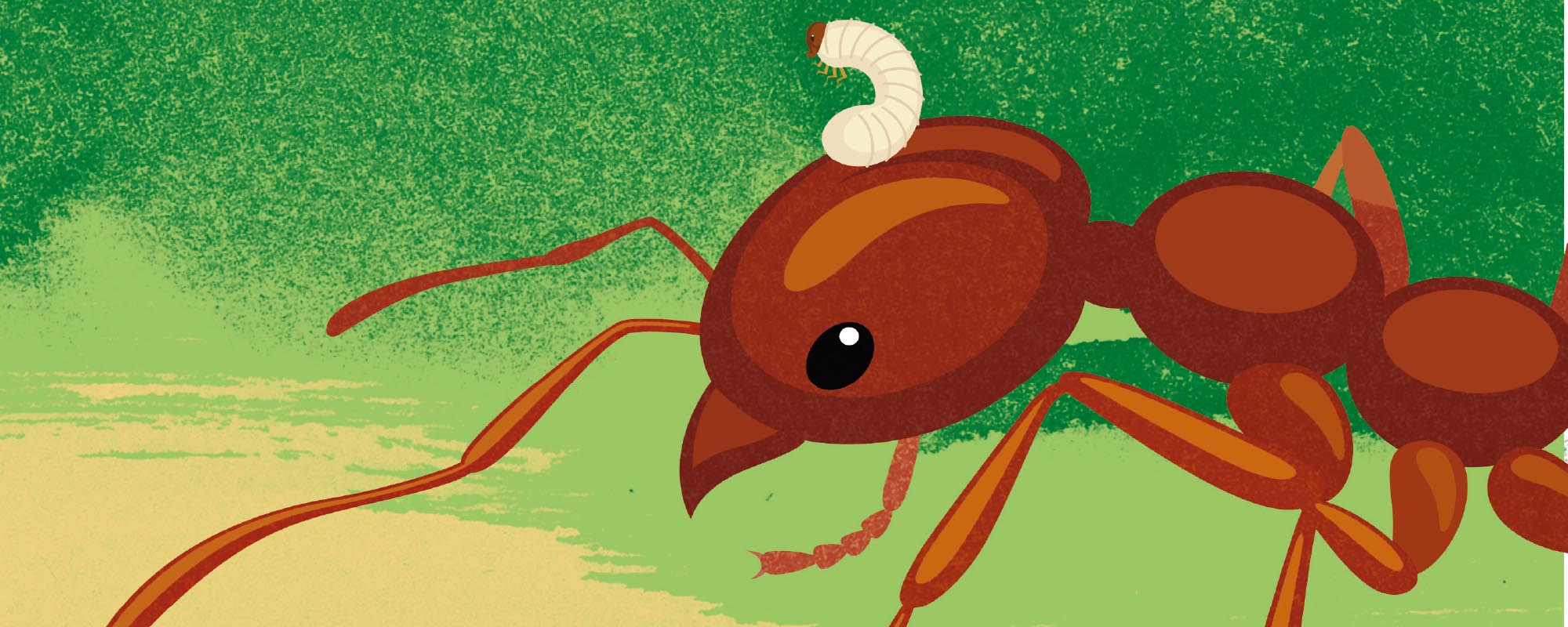Do you ever recall those moments in nature, where tiny insects seem to mistake you for a tree? Not only do they walk vertically upwards with incredible grip, but as they are brushed off and fall to the ground, they just nonchalantly walk away. No big deal. Except, when put into perspective, an ant falling from your arm is as though a person fell off a rooftop and walked away untouched. Why do small insects, and ants specifically, never seem to take any fall damage?
Continue readingFor the love of ants
The relationships between ants and other organisms can be just as complex as the subterranean networks they tunnel. Thomas Cassar takes a closer look at how these insects farm, steal, and co-habit.
Some ants’ tendency to ‘farm’ aphids (plant sap-sucking insects) for their sweet honeydew is decades-old knowledge. Cynics use this phenomenon to downplay the achievements of humans: look, an animal the size of a sesame seed had mastered agriculture long before human beings.
But aphids aren’t alone in this world of ant-coexistence. There’s a specialised group of animals which ignore the opinion of disgruntled roommates worldwide, seeking out the company of others. These are the myrmecophiles, literally ‘ant-lovers’. Such a phrase may conjure up an image of a great expert, maybe someone like the American biologist E. O. Wilson, pouring over an anthill (that would be a myrmecologist). Myrmecophile is an organism that just can’t live without ants.
The Ant Nest Ecosystem
Ants’ nests are prime real estate for the enterprising and the brave. If you can somehow get on good terms with your ant hostesses, you’re guaranteed a temperature-regulated shelter free of predators. And if there’s one thing all living things agree upon, it’s that you don’t say ‘no’ to a free bed and meal. But there’s always an adaptive fee to pay.

There are chambers for the brood, guards, the queen, and for food storage. The nest’s surroundings can yield rich pickings, too — the foraging routes, for instance. But if you’re tiny, good at holding on for dear life, or look like a nightmare straight out of Ridley Scott’s Alien, then the bodies of ants can be your home.
Many mites — tiny arachnids — feed on ants as parasites. The highly specialised mite Macrocheles rettenmeyeri just can’t resist a sip of army ant blood, and to get its meal it latches onto the ant’s last foot segment. But army ants can’t do their job with a bad foot; they form protective clusters by hooking each other’s claws together. So the mite earns its keep by converting its whole body into an extra ant’s foot. When the ant needs to use its claws as gripping hooks, the mite’s legs bend to serve the same purpose.
Antennophorus mites are another kind of ‘considerate’ parasite. Taking up positions on either side of the ant’s head or abdomen, they create a balanced load. Although it would be better for the ant if these thieves of regurgitated food weren’t there at all, this balancing act somewhat reduces the problem.
Patting someone’s head for a snack might not be recommended in human society, but for ants, sharing regurgitated food after a few antennae-taps is a way to communicate and strengthen social bonds among nest-mates. It’s also nutrition on tap for intruders who know how to say the magic word. So apart from lapping up food as it is passed from one ant to another, Antennophorus stroke the ant’s antennae with their legs in a way which mimics the touch signals from other ants requesting food — and hey presto, the host presents a globule of food, glorious food.
The trails of foraging ants can also offer an easy meal. One species which takes advantage is the Amphotis beetle. It waits for ants heavily laden with food, and like a highwayman of the undergrowth, gets the ant to regurgitate food by drumming on its head with its antennae.
Antennophorus stroke the ant’s antennae with their legs in a way which mimics the touch signals from other ants requesting food — and hey presto, the host presents a globule of food, glorious food.
The myrmecophile VIPs have adapted to gain exclusive access to the most precious confines of any nest: the brood chamber. Here, ants tend to their larvae day and night, guarding them fiercely, and feeding them generously. To live a luxurious life here, you need to get under the radar. The ingenious larvae of beetles have learnt to not only mimic the food-begging behavior of the ants’ own larvae, but they mask their intrusive presence by releasing a pheromone which triggers brood-tending behaviour. The beetle has mastered these mechanisms so well that its larvae end up getting a bigger helping of food than the young ants themselves.
You scratch my thorax, and I’ll scratch yours
Many myrmecophilous relationships are truly reciprocal. Some caterpillars of blue butterflies (Lycaenidae) seek out ants’ care and protection in exchange for a concentrated sugar solution secreted by a gland on their back. In some treehopper species, which exchange honeydew for protection, females abandon their young early on to the care of their farmers, being able to produce more clutches of eggs in the meantime.
The benefits of reciprocity can be so great that they may change the way ants live their lives and build their nests. Malaysian herdsmen ants (Dolichoderus cuspidatus) have no permanent nests, instead constructing shelters out of their own living bodies to protect their livestock — honeydew-producing mealybugs. When the mealybugs’ plants run dry and all seems lost, the ants pull up their socks and efficiently transport the mealybugs to fresher pastures. The discovery of this behaviour in 1985 was the first known case of non-human nomadic herding.
To live a luxurious life here, you need to get under the radar.
One need not travel to far-flung forests to appreciate the world of ants. Prof. David Mifsud (Institute of Earth Systems, University of Malta) recently worked on a study which brought the total known ant species in the Maltese Islands up to 70, a world with its own cast of characters. There are clean-up crews of blind, white woodlice scavenging the nests of harvester ants. Golden nicoletiidae silverfish zoom around, feeding on debris and stealing the odd morsel of regurgitated food and getting away with it, because the silverfish have learned to copy their hosts’ nest’s unique identifying odour. A sub-endemic, 4mm-long cricket (Myrmecophilus baronii) lives with carpenter ants, its wings lost in the course of evolution, along with much of its eyesight. A ground beetle (Siagona europaea) uses the secretions of its ant prey to make itself less detectable as it hunts.
From an ant’s perspective, living with other insects rather than eating them may ensure that precious resources are always in stock — much the same reason why humans went from hunter-gatherers to farmers. For the myrmecophile, there is one good reason amongst many for moving in with ants. By providing the ants with a useful resource, you avoid becoming their breakfast, lunch, or dinner. If you can’t beat them, join them.
Further reading:
Mifsud D. & Lapeva-Gjonova, A. (2019). ‘Additions to the ant fauna (Hymenoptera: Formicidae) of the Maltese Islands.’ ARPHA Conference Abstracts 2: e46475.
Talarico, F., Bonacci, T., Brandmayr, P., Dalpozzo, R., De Nino, A., Giglio, A., Tagarelli, A. & Zetto Brandmayr, T. (2009). ’Avoiding ant detection in Siagona europaea Dejean 1826 (Coleoptera Carabidae): an evolutionary step towards true myrmecophily.’ Ethology Ecology & Evolution, 21(1), 45–61. doi: 10.1080/08927014.2009.9522510.
Von Beeren, C., Schulz, S., Hashim, R., & Witte, V. (2011). ’Acquisition of chemical recognition cues facilitates integration into ant societies.’ BMC Ecology, 11(1), 30. doi: 10.1186/1472-6785-11-30.


